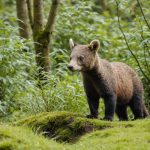Overview of Wildlife Disease Spread in the UK
Understanding how wildlife diseases spread is crucial to protecting both animal and human populations in the UK. Various diseases can make the jump from domestic environments to the wild, with pets often becoming unsuspecting vectors in this process. Disease transmission typically occurs through direct contact or environmental contamination, where pets may introduce pathogens to natural habitats.
Diseases like distemper, parvovirus, and mange can travel from seemingly healthy pets to wild animal populations, which may not have built-in immunity against such ailments. The concern is not just for the wildlife itself but also due to public health implications that arise from disease exchanges between domestic and wild ecosystems. Zoonotic diseases, such as rabies, pose a direct threat by potentially spreading from infected wildlife to humans.
A voir aussi : The Impact of Beaver Reintroduction on UK River Ecosystems: A Deep Dive into Nature’s Engineers
Effective disease management must prioritize monitoring interactions between pets and local wildlife. Educating pet owners on the risks involved and enforcing responsible pet care can mitigate the threat of such unwanted disease spread. Policies may include maintaining appropriate vaccination schedules and preventing unsupervised roaming in protected wildlife areas. Through these efforts, we can reduce the incidences of transmission, shielding both wildlife and humans from potential outbreaks.
Monitoring Strategies Implemented in the UK
In the UK, a variety of surveillance programs focus on wildlife and pets to ensure ecosystem balance and animal welfare. These programs employ diverse monitoring techniques including the use of technology and data analytics. One effective method involves deploying motion-activated cameras in natural habitats to track species behaviour without intrusion.
Sujet a lire : Exploring Habitat Management Strategies by UK Wildlife Trusts to Support Diverse Species
For domestic animals, wearable devices have become a popular choice, enabling the collection of data related to health and location. These devices transmit information via GPS, allowing owners and authorities to monitor pets efficiently. Such data helps in identifying trends and potential health issues, further aiding in preventive measures.
Technology plays a pivotal role, with data analytics offering insights into animal populations and their interactions. Information garnered from satellite imagery assists in monitoring habitat changes and can prompt immediate action if detrimental patterns emerge.
These efforts often result from collaborations between the government and research institutions. Shared resources and expertise facilitate comprehensive studies, leading to more informed decisions regarding animal conservation and protection. Specialised institutions like the UK Centre for Ecology & Hydrology work alongside governmental bodies to ensure these monitoring strategies are effectively implemented, paving the way for sustained ecological vigilance.
Key Organizations Involved in Monitoring and Intervention
Understanding how various entities collaborate is vital for successful wildlife protection. Stakeholder Collaboration ensures the efficient pooling of resources and expertise to address wildlife health challenges.
Governmental Agencies
Governmental agencies play a critical role in the oversight and implementation of wildlife health initiatives. Often, they lead in creating regulations and coordinating efforts among different stakeholders. By maintaining databases, they provide essential data that informs intervention strategies. Furthermore, governmental bodies often provide funding and logistical support for conservation efforts.
Veterinary Practices
In the realm of wildlife health, Veterinary Involvement is indispensable. Veterinarians contribute expert knowledge in diagnostics and treatment, ensuring animals receive appropriate care. Their participation in field research and their ability to quickly respond to health crises significantly enhance the overall efforts in wildlife conservation. Moreover, veterinary practices often provide on-the-ground support during wildlife health emergencies, offering specialized care when needed.
Conservation Organizations
Conservation organizations serve as the bridge between governmental agencies and local communities. They focus on implementing practical conservation strategies and raising awareness about species at risk. Through educational programs and direct action, these organizations mobilize public support and involvement. Notably, successful interventions often result from effective collaboration between conservation entities and other stakeholders, demonstrating the importance of unified efforts in preserving wildlife.
Disease Intervention Strategies in the UK
The United Kingdom employs a variety of disease management approaches to safeguard public health. A key component of these efforts includes effective prevention strategies which largely depend on comprehensive vaccination programs and accessible treatments. Vaccinations are paramount in both human and animal health, playing a crucial role in mitigating the spread of infectious diseases among the general population and pets.
Specific health protocols are meticulously designed and implemented to cater to community needs, focusing on both prevention and response measures. These protocols often involve routine health checks and vaccination schedules, ensuring timely intervention and reducing the risk of disease outbreaks.
Moreover, initiatives aimed at raising public awareness are integral to this strategy. By educating the community about disease prevention tactics and health practices, these programs foster a proactive approach towards health maintenance. Local governments often collaborate with healthcare professionals to deliver these educational campaigns, encouraging voluntary vaccination uptake and hygiene practices.
Community involvement further strengthens disease management efforts, as it ensures that interventions are culturally appropriate and widely accepted. Through public engagement and outreach programs, communities are empowered to take active roles in safeguarding both individual and public health.
Challenges in Combating Wildlife Disease Spread
Navigating the obstacles related to wildlife disease resistance presents a formidable challenge. Stakeholders, ranging from local communities to international conservation agencies, encounter significant hurdles in identifying and managing outbreaks. Disease resistance in wildlife can complicate efforts, as pathogens adapt to environmental changes and spread more swiftly. These adaptations require continual monitoring and rapid response to prevent escalation.
Moreover, climate change exacerbates these issues. As temperatures rise, habitats alter, leading to increased interactions between species and promoting the spread of diseases. Similarly, urbanization is a double-edged sword: while it can lead to better monitoring infrastructure, it also forces wildlife into closer proximity with human populations, increasing disease transmission risks.
Funding issues further compound these challenges. Resource allocation for wildlife disease management often competes with other urgent public health and environmental priorities. Limited funding affects everything from research to on-ground response capabilities. Effective solutions require not only adequate resources but strategic distribution and utilization.
Key strategies could include forming partnerships across sectors to pool resources and promote sustainable practices. By understanding and addressing these obstacles, stakeholders can better prepare and respond to the threats posed by emerging diseases in wildlife populations.
Success Stories and Case Studies
Exploring successful interventions is essential for understanding what works in practice. In the UK, several case studies highlight effective, evidence-based strategies. For instance, a major urban area implemented an after-school programme to combat youth delinquency, rooted in evidence-based practices. This initiative demonstrated remarkable results, leading to a significant reduction in local crime rates and improved school attendance over several years.
These interventions focus on long-term benefits, employing strategies that are meticulously researched and proven. They showcase how the application of case studies and evidence-based practices can yield positive outcomes across communities. Furthermore, the implementation of such programmes often results in qualitative improvements in community cohesion and individual well-being.
Another notable example involves a mental health initiative that employed evidence-based practices to support at-risk adolescents. Over time, reports indicated enhanced mental health outcomes and reduced hospital admissions, painting a vivid picture of long-lasting benefits and successful implementation.
Ultimately, these case studies serve as a blueprint for others looking to adopt similar strategies. They underscore the importance of basing interventions on credible evidence to ensure that the implemented solutions truly address the targeted issues.
Future Directions for Monitoring and Intervention
Identifying future strategies is essential for improving wildlife disease control. One critical research need involves enhancing monitoring techniques to detect diseases early. Advanced methods, such as machine learning, could predict outbreak patterns, providing a proactive stance against epidemics.
Another significant aspect is policy development. Governments and organisations must adjust policies to better manage emerging diseases. This might include stricter biosecurity measures or increased funding for disease research. Policies that are adaptable are vital in responding to evolving challenges effectively.
Furthermore, an integrated approach is required, combining both technological and traditional methods. Tapping into local knowledge, alongside cutting-edge technology, provides a more comprehensive strategy for disease intervention. This could be instrumental in preventing potential outbreaks.
Finally, fostering collaboration among scientists, policymakers, and local communities will be crucial. These partnerships can drive innovative solutions and ensure that research is implemented practically. Engaging communities in the decision-making process also builds trust and promotes sustainable practices.
The vision for integrated approaches is promising, with potential to create robust networks for disease control. By prioritizing both prevention and adaptability, we can enhance the resilience of ecosystems against future threats.











